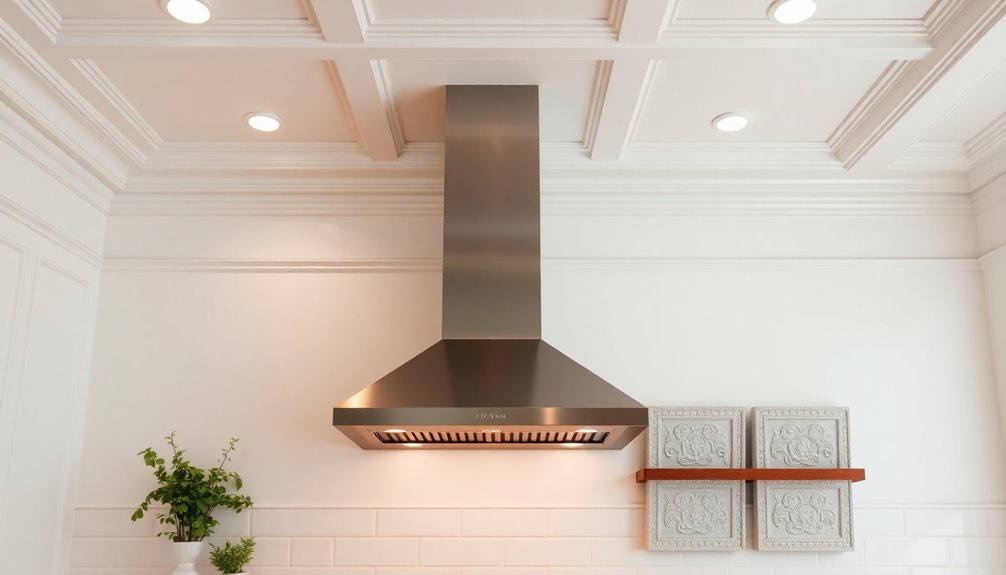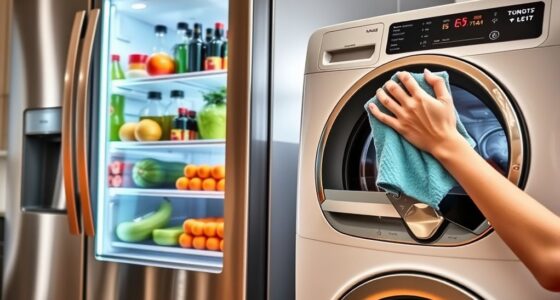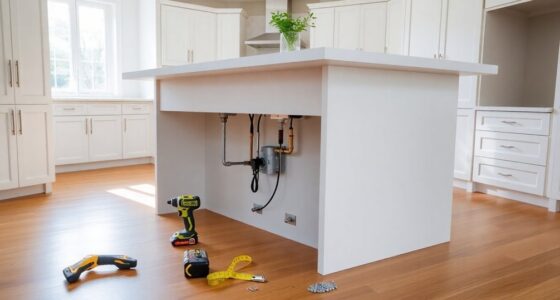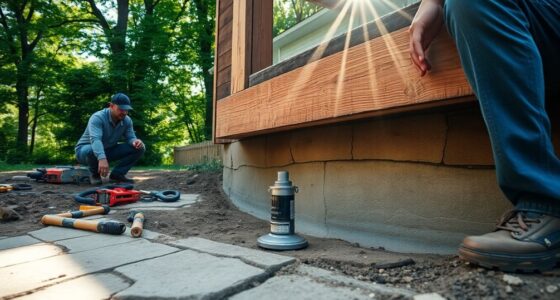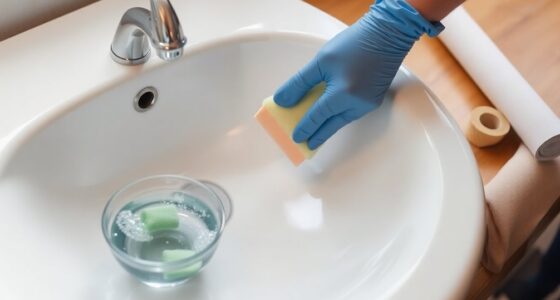To protect your kitchen ceiling from grease, start by installing a high-quality range hood that fits your cooking area and regularly clean it to prevent buildup. Use splatter guards when cooking, cover pots, and maintain a consistent cleaning schedule for your ceiling. Choose suitable cleaning products to effectively tackle grease. Finally, consider applying protective coatings to your surfaces for long-lasting protection. You'll find more tips and techniques to keep your kitchen sparkling clean.
Key Takeaways
- Install a high-quality range hood that matches your cooking surface for effective grease and smoke removal.
- Regularly clean the ceiling, focusing on high areas where grease accumulates, at least once a month.
- Use cooking techniques that minimize grease, such as lower temperatures and covering pots with lids.
- Apply protective coatings like high-gloss paint or polyurethane to create grease-resistant surfaces.
- Implement a cleaning schedule and involve family members to maintain a clean kitchen environment.
Install a High-Quality Range Hood
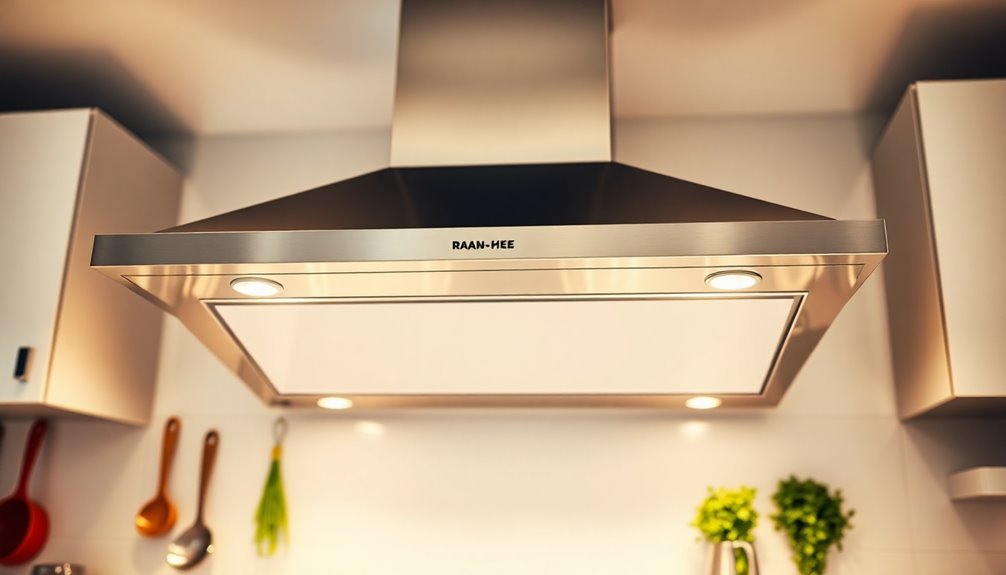
When you're cooking, it's vital to have a high-quality range hood installed, as it effectively removes grease, smoke, and steam from the air. Choosing a range hood that matches your kitchen's size and ventilation needs is essential for peak performance. Typically, the hood should at least match the width of your cooking surface.
Regular maintenance of the range hood, including cleaning or replacing filters, guarantees it operates effectively, preventing grease from accumulating in your kitchen atmosphere. Innovative range hoods with higher extraction rates capture more airborne particles, including grease, helping to maintain a cleaner kitchen environment and reduce ceiling stains.
Consider models with built-in lighting to enhance visibility and highlight any grease buildup, encouraging timely maintenance.
Regularly Clean the Ceiling
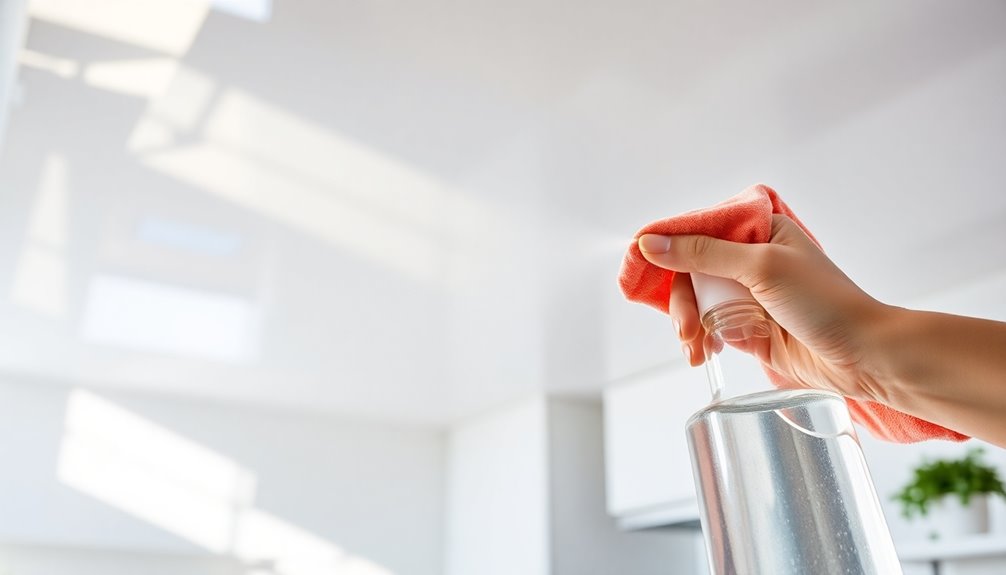
To keep your kitchen ceiling grease-free, establish a regular cleaning schedule that fits your lifestyle.
Use appropriate cleaners, like a degreaser, to tackle tough spots, and don't forget to focus on those high areas where grease tends to accumulate.
Staying on top of this routine will help maintain a fresh and healthy kitchen environment.
Establish Cleaning Schedule
Establishing a regular cleaning schedule is essential to keep your kitchen ceiling free from grease buildup. Aim to wash the ceiling every few months, and don't forget to integrate this into your regular kitchen cleaning routine. Using splatter screens while cooking can considerably reduce grease particles settling on your ceiling, minimizing grease accumulation.
Here's a simple table to help you plan:
| Frequency | Task | Notes |
|---|---|---|
| Monthly | Inspect for buildup | Adjust based on cooking |
| Every 3 months | Deep clean ceiling | Use a degreaser |
| Before holidays | Thorough clean | Prepare for guests |
| As needed | Spot clean | Check for grease spots |
Stay proactive with your schedule, and adjust it based on how often you cook!
Use Appropriate Cleaners
After you've set a cleaning schedule, using the right cleaners is key to keeping your kitchen ceiling grease-free.
Regularly clean with effective degreasers like Simple Green or TSP (trisodium phosphate) diluted in water. Always follow the manufacturer's instructions for the best results.
Apply your cleaner in small sections and let it dwell for a few minutes to break down grease effectively. Remember to work at a lower temperature to avoid any damage.
After cleaning, rinse the ceiling thoroughly with a damp rag or vacuum extractor to remove any residual cleaning agents. This step helps prevent streaking or discoloration.
Focus on High Areas
Cleaning your kitchen ceiling regularly is essential for maintaining a fresh and inviting space. It helps prevent that dingy yellow-brown film caused by grease and smoke residues. Using a degreaser like TSP can effectively break down stubborn buildup. Schedule a cleaning every few months, or more often if you cook frequently. Cooking at a lower heat can also help minimize grease, making it a good idea to keep your ceiling cleaner for longer.
| Action | Emotion Evoked |
|---|---|
| Regular cleaning | Peace of mind |
| Using TSP | Confidence in cleanliness |
| Cooking at lower heat | Control over mess |
| Employing splatter screens | Proactive protection |
| Scheduling cleanings | Commitment to health |
Use Splatter Guards While Cooking
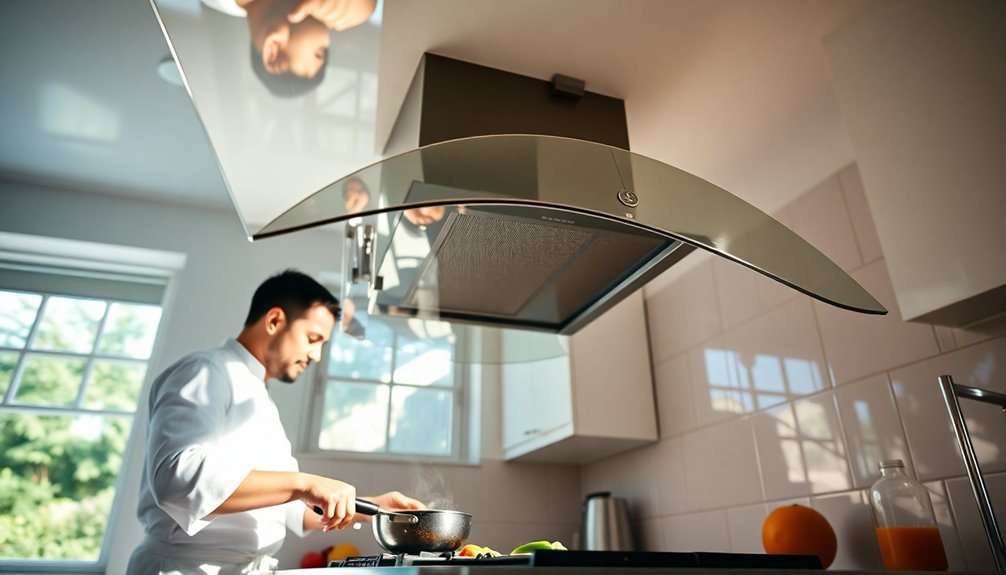
When you're cooking, splatter guards can be a game changer for keeping your kitchen clean. They effectively prevent oil and food particles from escaping, greatly reducing grease buildup on your kitchen ceiling.
Here are a few benefits of using splatter guards:
- Contain splatters: They keep oil and food from escaping, minimizing mess.
- Control steam: They help contain steam, preventing moisture from contributing to grease accumulation.
- Versatile fit: Many splatter guards fit various pan sizes for multiple cooking methods.
- Easy to clean: Regular cleaning after use helps maintain their effectiveness.
Maintain a Consistent Cleaning Schedule
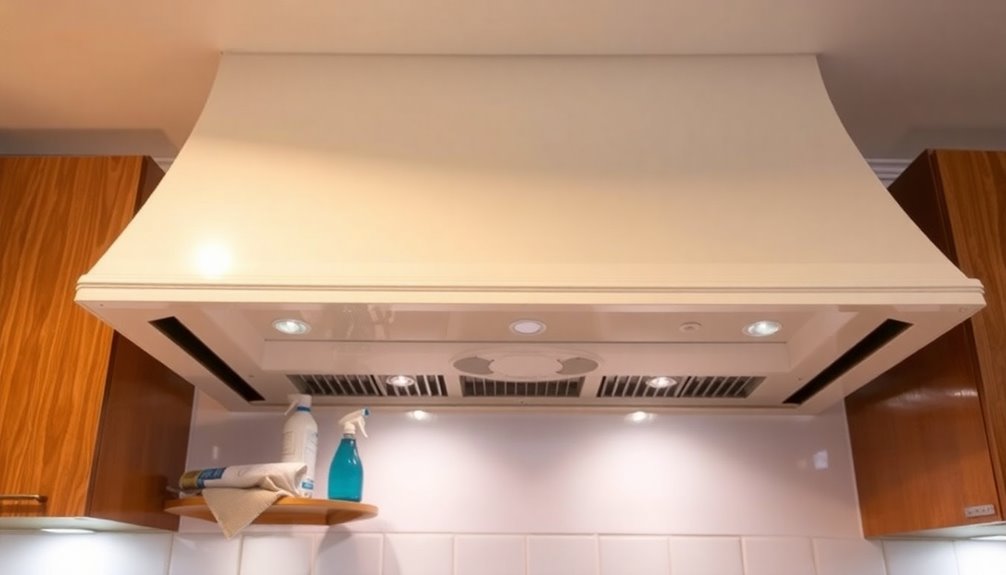
Regularly maintaining a cleaning schedule is essential for keeping your kitchen ceiling grease-free.
Make sure you establish a routine that includes wiping down the ceiling at least once a month. This prevents grease buildup and promotes a cleaner environment.
During each cleaning session, use a degreaser specifically designed for kitchen surfaces to effectively remove any accumulated grease.
You'll also need to use TSP for any tougher grime during deep cleaning sessions every three to six months.
Monitor your cooking activities and adjust your cleaning schedule accordingly if you notice increased grease exposure.
Involving family members in the process helps share the responsibility and keeps your kitchen in top shape, ensuring your ceiling remains in good condition.
Choose the Right Cleaning Products
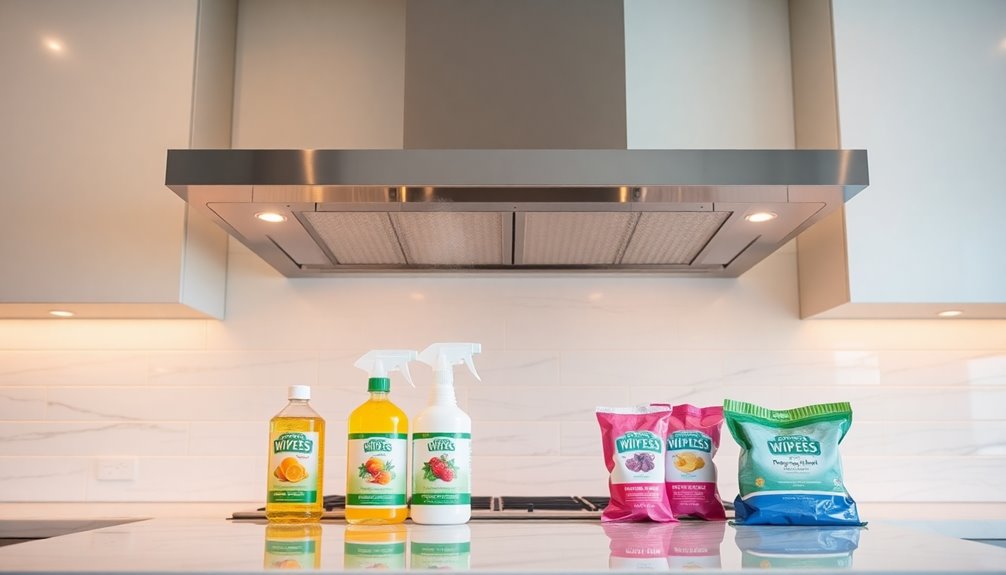
Choosing the right cleaning products is essential for effectively tackling grease on your kitchen ceiling. Here's what you should consider:
- Industrial-strength degreasers: Products like Husky 901 can break down heavy grease buildup.
- Simple degreasers: If your ceiling isn't too dirty, Simple Green is a great option that's less harsh.
- Saponification properties: Look for cleaners that turn grease into soap, making it easier to wash away.
- Non-toxic and environmentally friendly: Always prioritize cleaners that are safe for food preparation areas.
Don't forget to let the cleaning products dwell for a sufficient time to penetrate the grease.
This will enhance their effectiveness, making your cleaning process smoother and more efficient.
Cover Appliances and Surfaces
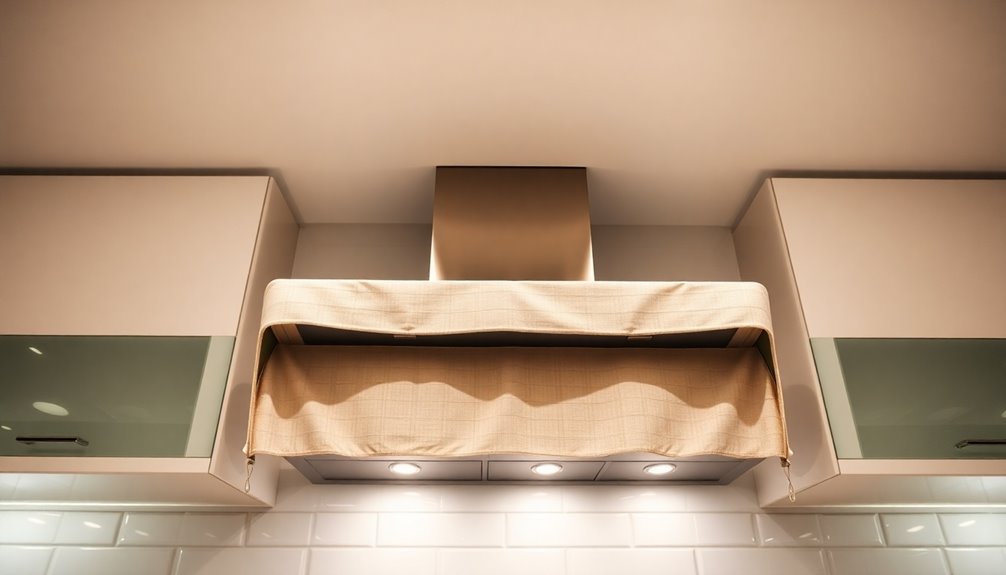
To keep your kitchen ceiling grease-free, start by using protective covers for your appliances when they're not in use.
Installing grease guards around cooking areas can also help shield your walls and ceiling from splatters.
These simple steps make a big difference in preventing buildup and maintaining a clean cooking environment.
Use Protective Covers
While cooking can be a delicious endeavor, it often leaves behind a trail of grease that can mar your kitchen ceiling. To combat this, using protective covers is essential.
Here are some effective strategies:
- Use splatter screens over frying pans and pots to minimize grease escape.
- Cover appliances with towels or specialized protective covers to prevent dust and grease buildup.
- Regularly use lids on pots and pans while cooking to reduce steam and splatter.
- Choose high-gloss paint for your kitchen ceiling, making it easier to clean and resistant to grease adhesion.
Install Grease Guards
Even with protective covers in place, grease can still find its way to your kitchen ceiling. To combat this, install grease guards or splatter screens over your frying pans and pots. These tools effectively trap oil, preventing it from escaping into the air.
Additionally, using lids on pots and pans while cooking can greatly reduce steam and grease splatter. When your stovetop isn't in use, cover it with towels or specialized covers to protect it from grease buildup.
You might also consider adding grease catchers or splatter shields attached to the walls or ceiling above cooking areas to intercept airborne particles.
Finally, remember to regularly clean these protective coverings to keep them effective and your kitchen ceiling grease-free.
Monitor Cooking Techniques

Adjusting your cooking techniques can make a big difference in reducing grease buildup on your kitchen ceiling.
Here are some effective strategies to contemplate:
- Cook at Lower Temperatures: Lowering the heat can greatly cut down on grease emissions.
- Use Cooking Sprays: Instead of pouring oil directly, try cooking sprays to minimize grease production.
- Cover Pots and Pans: Lids help contain splatter and steam, preventing grease from escaping into the air.
- Choose Non-Stick Cookware: This allows you to cook with less fat, resulting in less grease on surfaces.
Consider Protective Coatings for Surfaces
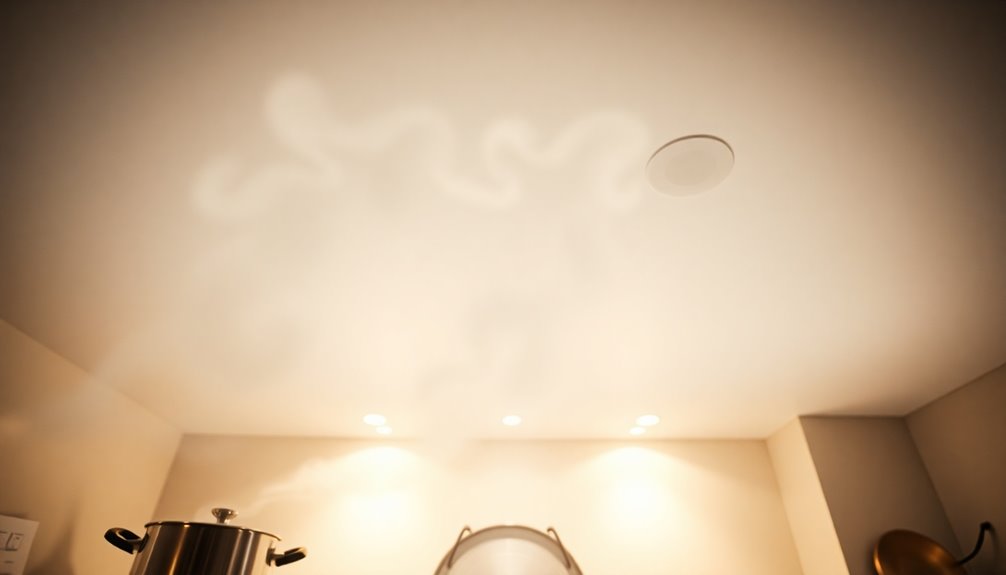
To effectively combat grease buildup on your kitchen ceiling, consider applying protective coatings to your surfaces. High-gloss or semi-gloss paint creates a smoother surface, making it easier to clean and less prone to grease accumulation. Specialized coatings like polyurethane or epoxy offer a durable, grease-resistant barrier that simplifies maintenance.
Here's a quick comparison of options:
| Coating Type | Benefits | Maintenance Frequency |
|---|---|---|
| High-Gloss Paint | Easier to clean; smooth surface | Every 5 years |
| Polyurethane | Durable; grease-resistant | Every 3 years |
| Epoxy | Strong barrier; minimizes grease adherence | Every 4 years |
Regularly reapplying these coatings keeps your ceiling looking fresh while enhancing your kitchen's aesthetics.
Frequently Asked Questions
How to Keep Grease off a Kitchen Ceiling?
To keep grease off your kitchen ceiling, start by installing a good range hood that captures smoke and steam.
Use splatter screens or lids while cooking to contain oil.
Consider cooking methods like steaming or using an air fryer, which create less grease.
Regularly clean your ceiling, especially if you're cooking high-fat foods.
Finally, guarantee proper ventilation by opening windows or using exhaust fans to help dissipate grease and moisture.
What Is the Best Degreaser for Kitchen Ceilings?
Did you know that a dirty kitchen ceiling can harbor over 50 different types of bacteria?
To tackle this, the best degreaser for kitchen ceilings is trisodium phosphate (TSP), known for breaking down tough grease and grime.
For heavy-duty cleaning, try Husky 901, which effectively targets stubborn buildup.
If your ceiling's only slightly greasy, a diluted Simple Green solution works well.
Just remember to let the degreaser dwell before wiping for ideal results!
How to Prevent Grease Build up on Top of Kitchen Cabinets?
To prevent grease buildup on top of your kitchen cabinets, start by regularly cleaning them with a degreaser or a vinegar-water mixture.
Use splatter screens or lids while cooking to keep oil and steam contained.
Consider installing a range hood to capture smoke and grease particles.
Improve ventilation by keeping windows open or using exhaust fans.
Finally, store cooking oils in sealed containers to minimize spills and airborne grease.
How Do I Protect My Kitchen Wall From Grease?
To protect your kitchen walls from grease, start by installing a high-quality range hood above your cooking area.
Use splatter screens or lids while frying to minimize oil splashes.
Opt for washable, high-gloss paint on your walls, making cleanup easier.
Regularly wipe down the surfaces with a degreaser or a vinegar-water mixture to tackle any grease buildup.
If possible, position your cooking appliances away from the walls for added protection.
Conclusion
By taking these steps, you can effectively protect your kitchen ceiling from grease and keep it looking fresh. Did you know that a well-maintained range hood can reduce airborne grease particles by up to 90%? This means not only a cleaner ceiling but also a healthier cooking environment. So, invest in good tools, stay on top of your cleaning routine, and enjoy a kitchen that's both functional and aesthetically pleasing!
